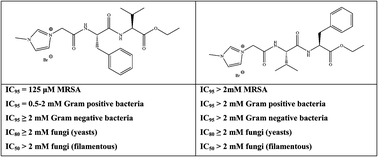Antimicrobial toxicity studies of ionic liquids leading to a ‘hit’ MRSA selective antibacterial imidazolium salt†
Abstract
Imidazolium salts can be classed as

* Corresponding authors
a
School of Chemical Sciences, Dublin City University, Glasnevin, Dublin 9, Ireland
E-mail:
Nick.Gathergood@dcu.ie
Fax: +353 1 7005503
Tel: +353 1 7007860
b Department of Inorganic and Organic Chemistry, Faculty of Pharmacy, Charles University, Heyrovského 1203, CZ-500 03, Hradec Králové, Czech Republic
c Department of Surfactant Technology, IQAC-CSIC, Jordi Girona 18-26, 08034 Barcelona, Spain
Imidazolium salts can be classed as

 Please wait while we load your content...
Something went wrong. Try again?
Please wait while we load your content...
Something went wrong. Try again?
D. Coleman, M. Špulák, M. T. Garcia and N. Gathergood, Green Chem., 2012, 14, 1350 DOI: 10.1039/C2GC16090K
To request permission to reproduce material from this article, please go to the Copyright Clearance Center request page.
If you are an author contributing to an RSC publication, you do not need to request permission provided correct acknowledgement is given.
If you are the author of this article, you do not need to request permission to reproduce figures and diagrams provided correct acknowledgement is given. If you want to reproduce the whole article in a third-party publication (excluding your thesis/dissertation for which permission is not required) please go to the Copyright Clearance Center request page.
Read more about how to correctly acknowledge RSC content.
 Fetching data from CrossRef.
Fetching data from CrossRef.
This may take some time to load.
Loading related content
